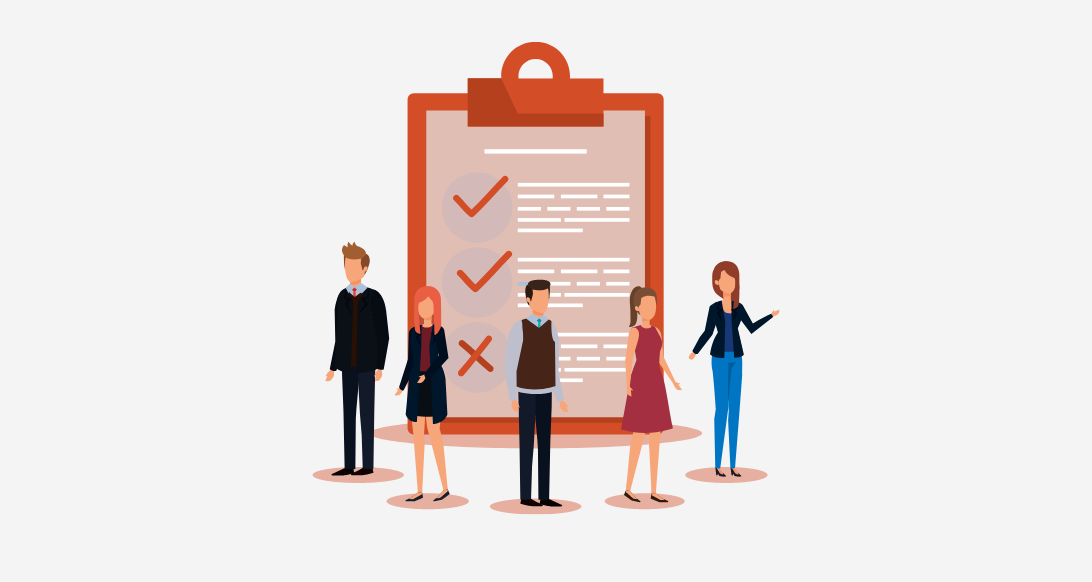The Definitive Guide to
Buyer Personas
In developing products and creating market messages, product managers must have clarity on the ideal user and buyer. The industry has adopted the term “persona” to refer to the ideal profiles of our customers.
In recent years, most product managers and product marketers have adopted the practice of creating personas to represent the types of people who buy and use their products.
Buyer personas present a composite picture of the various buying influences in a sale. A typical sale includes a decision-maker or economic buyer plus multiple technology reviewers. Most large-ticket purchases also include user buyers on the evaluation team.
Understanding buyer personas and how to compile them for your product will help you better understand your market and align internally to ensure a successful product launch. Read on to learn how.
What are buyer personas?
While different companies may approach buyer personas in any number of ways, the general consensus is that buyer personas are short descriptions of fictitious, archetypical customers that will most likely have a say in the purchasing decision. (User personas are equally important but separate, though there may be some overlap.) Essentially, they’re hypothetical biographies of each type of buyer you’re planning to market your product to.
Buyer personas can range from highly specific and detailed—almost bordering on dating profile-esque—or can be broader and more theme-based. For example, many companies choose to really paint a picture of their various types of buyers and assign each persona a name, age, race, ethnicity, gender, job title, likes/dislikes, hopes and dreams, and so on. (You get the idea). They may even include a stock photo of what the person might look like in real life. Other companies choose to leave out demographics to keep from pigeonholing their buyers and making assumptions about them that may or may not be true. Such personas may focus more on the buyers’ role within a company, who they report to, what problems they want your product to solve, etc.
Either way, be sure to also include in each persona, the person’s involvement in the purchase decision. Will they have real influence over the buying process, or are they more of a secondary or tertiary player? Are they the only decision-maker, or are there others?
Why buyer personas are important
However you decide to approach personas, it’s important to be strategic. Buyer personas are a powerful way to help us understand who we’re communicating with and provide clarity on your target for programming and for communication. Without them, you may be tempted to assume buyers are just like you. But you—and other employees in your organization—are rarely good representatives of your customers.
Many programmers mistake themselves as ideal programming targets. For that matter, so do many executives, salespeople and marketing people. On embracing personas, one company realized that their developers of programming tools were not representative of their users of programming tools. While both sets of developers were using Java, the vendor programmers were vastly more advanced than the customer programmers.
The persona concept helps product teams focus on the specific problems of a type of customer. And it helps product marketers connect with them when they’re ready to buy.
Smart product managers are creating innovative products that address specific problems of their personas instead of just building a glob of features and hoping they will sell. We cannot “create the need” for products people don’t want to buy.
The buyer persona helps us identify the right approach for reaching those who buy. Should we use Twitter, blogs, webinars, trade shows, traditional advertising? The better question is: Which of these reach our buyer personas?
Should we include a book reader, music player or currency converter? The better question is: Which feature set satisfies the user persona?
It’s easy to get stuck in the middle of competing opinions about how we should go to market and how we should launch a product. And then we may end up making decisions based on how to satisfy our internal audience. But, of course, that isn’t our goal. Our goal is to make decisions that are appropriate for our external audience. Building personas works to bring together all of our internal stakeholders and bring their attention back to the buyer—back to the real audiences that we need to influence to get a product to succeed rapidly and persistently over a long period of time.

The persona concept helps product teams focus on the specific problems of a type of customer.
Who owns the development of buyer personas?
While sales and other stakeholders may provide insight into buyer personas, the product marketing manager often owns the process of doing the research and developing the buyer personas. Each organization is different, and you may find that other roles (such as product manager or product owner) are suited to creating buyer personas.
How to develop buyer personas for your business
You may be tempted to search the internet for “buyer persona templates,” but at Pragmatic Institute, we’re strong believers in approaching your buyer personas without any preconceived notions. Each company, each product team should consider its own product when determining what’s important to include in its buyer personas and what’s not.
The good news is that buyer personas should be fairly concise—there won’t be a ton of writing involved—and there will be only a handful to complete. We can’t give you a specific number—the number of buyer personas you create will depend on your market and who is involved in the purchasing decision for your product—but it’s common to have somewhere around three to five personas per product.
Here are the steps to developing your buyer personas:
Conduct interviews with potential buyers
Speak one-to-one with people in your market to learn about their roles and responsibilities, what’s important to them, what their challenges are, how they’re currently solving them, why they buy and more. Obviously, you’ll want to ask questions that relate to your product, but be careful not to ask leading questions or give in to the temptation to sell them on your product. This is a discovery mission, not a sales call. Learn our best practices for conducting buyer interviews in our Uncovering Market Problems webinar. In general, you’ll need to conduct 10 to 20 interviews for patterns to emerge.
Identify trends
Once you begin to identify themes from your one-to-one interviews, then you can start grouping types of buyers together. Who has similar job roles, responsibilities, concerns? Which people are facing similar problems? Who is trying to accomplish the same thing as someone else?
Put together an outline of your suspected buyer personas. Next, you’ll test your hypotheses.
Survey customers
Once you have some preliminary buyer personas, now it’s time to confirm (or disprove) them. Surveying current customers via an online tool or with the help of a partner like UserTesting will help you validate your hypotheses. This data, which you can collect more of because it’s quicker than one-to-one interviews, will enable you to create a clearer picture of your target market and help you finalize your buyer personas.
Write persona descriptions
Summarize your findings into three, four, five—however many personas you need to represent the themes you uncovered in your research. Just be sure to not go overboard. Having too many personas may mean you’ve failed to truly identify your target market and may end up leading to further confusion and disorganization.
Gain buy-in
Once you’ve nailed down your buyer personas, you’ll need to gain buy-in from executives and key stakeholders, including sales, marketing, development and so forth. It’s crucial that everyone on the team be on the same page when it comes to who your buyers are. Be sure to present your research along with the personas to illustrate how and why you arrived at the personas you did.
Share, share, share
Finally, share your buyer personas far and wide (internally only, of course; they’re proprietary information). Host meetings, produce written summaries and discuss your personas often. Establish a habit that every member of the team refers to the buyer personas when creating external messaging and making decisions about product development and features.
Examples of buyer personas
To further illustrate what buyer personas are and how they can be useful, below are some examples. But remember, there is no template for your buyer personas. You will need to decide what type of information to collect and include in your product’s personas.
Sarah, the college student
Sarah is a student at the University of Best State Ever. She’s never not had a mobile phone; she’s never not had an ATM card; she’s never not had a computer; she’s never not had access to the internet. In almost every way, Sarah is different from her college professors, who had none of these things when they attended college. Professors who understand this disparity can relate their topics to Sarah’s college experience instead of their own. The best professors connect with the students—the best marketers do, too.
Sarah’s college requirements are much different than those of the “buyer,” Sarah’s mom and dad. The buyer wants a safe environment with a minimum number of parties. Sarah probably wants more parties and fewer early-morning classes.
Robin, the product manager
Robin is a product manager for an enterprise B2B vendor with a direct sales force. She manages all aspects of product management for three products. She is 35 years old with a college degree and some MBA classes. She earns over $100,000 a year and is eligible for a bonus based on company profit, product revenue and personal quarterly goals. Robin is a power user of Microsoft Office. She runs Internet Explorer and Firefox on the latest version of Microsoft Windows. She has a reasonably new laptop running 1280×1024 resolution or higher. Using Microsoft Outlook, Robin sends and receives over 75 emails each day; she attends a dozen internal meetings each week. A good day is when no one from sales wants her to drop everything she’s doing to help them with a deal.
With this profile, a vendor targeting product management has some very clear requirements. They can program to a high screen resolution; they must accommodate a computer not always connected to the internet; they can see that Robin is technically savvy and is likely to prefer a product based on the “tree” metaphor (in contrast to Sarah, who does not understand hierarchical filing).
The power of the profile is that it also gives permission to ignore buyers who do not fit the profile. The vendor can safely ignore Netscape, Safari and the other browsers; they can ignore Macintosh OSX Linux and older versions of Windows. This is not a judgment of technology; these environments are simply not statistically relevant among product managers. Every product does NOT have to accommodate every possible environment; instead, products should support and leverage the most likely environment to delight our persona.
Jon and Cheryl
Consider a Sales Force Automation (SFA) sale: the users are Jon, the account rep (someone who sells) and Cheryl, the director of a sales region (someone who manages salespeople). These two personas will use the product on a daily basis. Both are involved in the selection of an SFA tool. But Jon and Cheryl have different product requirements and different listening needs.
Both want to simplify status reporting. Cheryl is interested in consolidating all territory data; Jon is opposed to it. Neither Jon nor Cheryl will make the final buying decision but are likely to influence the decision-maker. The decision-maker (or economic buyer) is Peter, VP of Sales. In addition, the product must pass the technical evaluation for compliance, security and technical fit, requiring yet another persona definition for the IT buyer.
You can see that market segments quickly become critical here. A persona’s technology profile is likely to be completely different by market segment. The standard computing platform in a telecommunications company is different than that in a bank. If we wish to succeed in becoming a successful vendor, we must build a product that creates loyal users by satisfying the needs of account reps and their management. But we must also meet the buying requirements of the decision-maker and technology reviewers, or we’ll never get to the user personas.

there is no template for your buyer personas.
Persona archetypes vs. stereotypes
In our discussions of personas, we often get tripped up by the terms “archetype” and “stereotype.” They may be similar, but it’s important to understand the difference as to not conflate the two. At Pragmatic, we think of them like so:- An archetype is used to inform
- A stereotype is used to demean
Learn more about buyer personas
Buyer personas help you identify the right approach for developing for and communicating with your target market. Learn more about how to develop effective buyer personas that lead to more successful sales in Pragmatic Institute’s Market course today.





